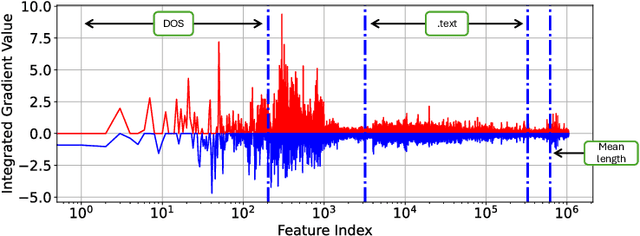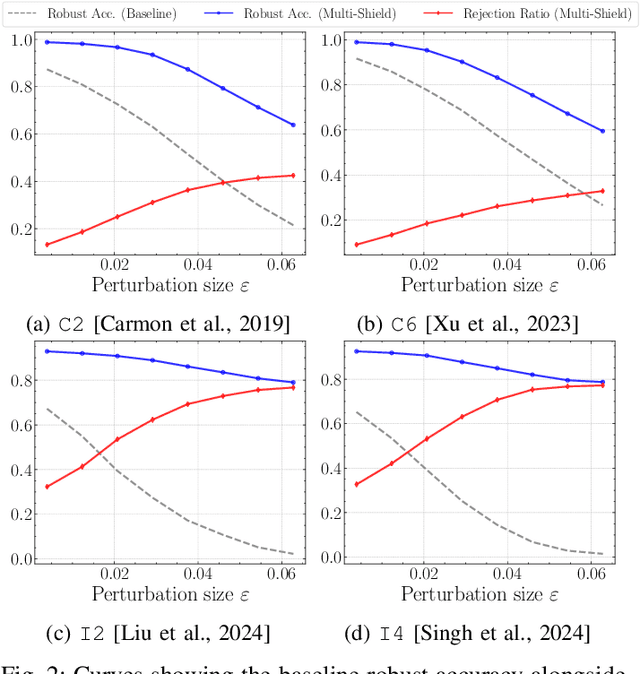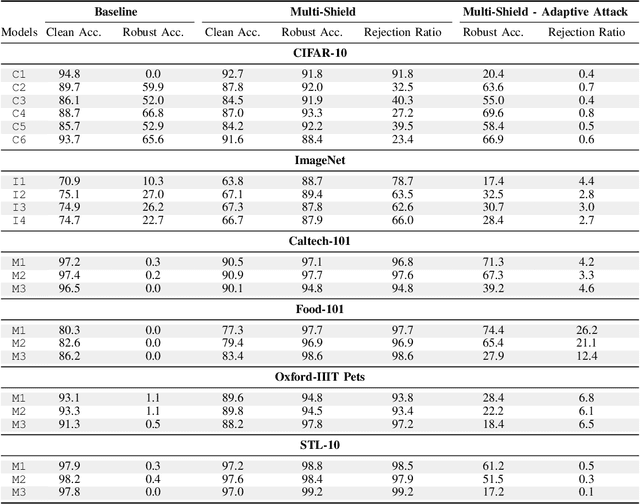Fabio Roli
A Neural Rejection System Against Universal Adversarial Perturbations in Radio Signal Classification
Jun 13, 2025Abstract:Advantages of deep learning over traditional methods have been demonstrated for radio signal classification in the recent years. However, various researchers have discovered that even a small but intentional feature perturbation known as adversarial examples can significantly deteriorate the performance of the deep learning based radio signal classification. Among various kinds of adversarial examples, universal adversarial perturbation has gained considerable attention due to its feature of being data independent, hence as a practical strategy to fool the radio signal classification with a high success rate. Therefore, in this paper, we investigate a defense system called neural rejection system to propose against universal adversarial perturbations, and evaluate its performance by generating white-box universal adversarial perturbations. We show that the proposed neural rejection system is able to defend universal adversarial perturbations with significantly higher accuracy than the undefended deep neural network.
Attention-based Adversarial Robust Distillation in Radio Signal Classifications for Low-Power IoT Devices
Jun 13, 2025Abstract:Due to great success of transformers in many applications such as natural language processing and computer vision, transformers have been successfully applied in automatic modulation classification. We have shown that transformer-based radio signal classification is vulnerable to imperceptible and carefully crafted attacks called adversarial examples. Therefore, we propose a defense system against adversarial examples in transformer-based modulation classifications. Considering the need for computationally efficient architecture particularly for Internet of Things (IoT)-based applications or operation of devices in environment where power supply is limited, we propose a compact transformer for modulation classification. The advantages of robust training such as adversarial training in transformers may not be attainable in compact transformers. By demonstrating this, we propose a novel compact transformer that can enhance robustness in the presence of adversarial attacks. The new method is aimed at transferring the adversarial attention map from the robustly trained large transformer to a compact transformer. The proposed method outperforms the state-of-the-art techniques for the considered white-box scenarios including fast gradient method and projected gradient descent attacks. We have provided reasoning of the underlying working mechanisms and investigated the transferability of the adversarial examples between different architectures. The proposed method has the potential to protect the transformer from the transferability of adversarial examples.
Empirical Quantification of Spurious Correlations in Malware Detection
Jun 11, 2025



Abstract:End-to-end deep learning exhibits unmatched performance for detecting malware, but such an achievement is reached by exploiting spurious correlations -- features with high relevance at inference time, but known to be useless through domain knowledge. While previous work highlighted that deep networks mainly focus on metadata, none investigated the phenomenon further, without quantifying their impact on the decision. In this work, we deepen our understanding of how spurious correlation affects deep learning for malware detection by highlighting how much models rely on empty spaces left by the compiler, which diminishes the relevance of the compiled code. Through our seminal analysis on a small-scale balanced dataset, we introduce a ranking of two end-to-end models to better understand which is more suitable to be put in production.
Buffer-free Class-Incremental Learning with Out-of-Distribution Detection
May 29, 2025Abstract:Class-incremental learning (CIL) poses significant challenges in open-world scenarios, where models must not only learn new classes over time without forgetting previous ones but also handle inputs from unknown classes that a closed-set model would misclassify. Recent works address both issues by (i)~training multi-head models using the task-incremental learning framework, and (ii) predicting the task identity employing out-of-distribution (OOD) detectors. While effective, the latter mainly relies on joint training with a memory buffer of past data, raising concerns around privacy, scalability, and increased training time. In this paper, we present an in-depth analysis of post-hoc OOD detection methods and investigate their potential to eliminate the need for a memory buffer. We uncover that these methods, when applied appropriately at inference time, can serve as a strong substitute for buffer-based OOD detection. We show that this buffer-free approach achieves comparable or superior performance to buffer-based methods both in terms of class-incremental learning and the rejection of unknown samples. Experimental results on CIFAR-10, CIFAR-100 and Tiny ImageNet datasets support our findings, offering new insights into the design of efficient and privacy-preserving CIL systems for open-world settings.
SoK: On the Offensive Potential of AI
Dec 24, 2024



Abstract:Our society increasingly benefits from Artificial Intelligence (AI). Unfortunately, more and more evidence shows that AI is also used for offensive purposes. Prior works have revealed various examples of use cases in which the deployment of AI can lead to violation of security and privacy objectives. No extant work, however, has been able to draw a holistic picture of the offensive potential of AI. In this SoK paper we seek to lay the ground for a systematic analysis of the heterogeneous capabilities of offensive AI. In particular we (i) account for AI risks to both humans and systems while (ii) consolidating and distilling knowledge from academic literature, expert opinions, industrial venues, as well as laymen -- all of which being valuable sources of information on offensive AI. To enable alignment of such diverse sources of knowledge, we devise a common set of criteria reflecting essential technological factors related to offensive AI. With the help of such criteria, we systematically analyze: 95 research papers; 38 InfoSec briefings (from, e.g., BlackHat); the responses of a user study (N=549) entailing individuals with diverse backgrounds and expertise; and the opinion of 12 experts. Our contributions not only reveal concerning ways (some of which overlooked by prior work) in which AI can be offensively used today, but also represent a foothold to address this threat in the years to come.
Robust image classification with multi-modal large language models
Dec 13, 2024



Abstract:Deep Neural Networks are vulnerable to adversarial examples, i.e., carefully crafted input samples that can cause models to make incorrect predictions with high confidence. To mitigate these vulnerabilities, adversarial training and detection-based defenses have been proposed to strengthen models in advance. However, most of these approaches focus on a single data modality, overlooking the relationships between visual patterns and textual descriptions of the input. In this paper, we propose a novel defense, Multi-Shield, designed to combine and complement these defenses with multi-modal information to further enhance their robustness. Multi-Shield leverages multi-modal large language models to detect adversarial examples and abstain from uncertain classifications when there is no alignment between textual and visual representations of the input. Extensive evaluations on CIFAR-10 and ImageNet datasets, using robust and non-robust image classification models, demonstrate that Multi-Shield can be easily integrated to detect and reject adversarial examples, outperforming the original defenses.
On the Robustness of Adversarial Training Against Uncertainty Attacks
Oct 29, 2024



Abstract:In learning problems, the noise inherent to the task at hand hinders the possibility to infer without a certain degree of uncertainty. Quantifying this uncertainty, regardless of its wide use, assumes high relevance for security-sensitive applications. Within these scenarios, it becomes fundamental to guarantee good (i.e., trustworthy) uncertainty measures, which downstream modules can securely employ to drive the final decision-making process. However, an attacker may be interested in forcing the system to produce either (i) highly uncertain outputs jeopardizing the system's availability or (ii) low uncertainty estimates, making the system accept uncertain samples that would instead require a careful inspection (e.g., human intervention). Therefore, it becomes fundamental to understand how to obtain robust uncertainty estimates against these kinds of attacks. In this work, we reveal both empirically and theoretically that defending against adversarial examples, i.e., carefully perturbed samples that cause misclassification, additionally guarantees a more secure, trustworthy uncertainty estimate under common attack scenarios without the need for an ad-hoc defense strategy. To support our claims, we evaluate multiple adversarial-robust models from the publicly available benchmark RobustBench on the CIFAR-10 and ImageNet datasets.
Adversarial Pruning: A Survey and Benchmark of Pruning Methods for Adversarial Robustness
Sep 02, 2024Abstract:Recent work has proposed neural network pruning techniques to reduce the size of a network while preserving robustness against adversarial examples, i.e., well-crafted inputs inducing a misclassification. These methods, which we refer to as adversarial pruning methods, involve complex and articulated designs, making it difficult to analyze the differences and establish a fair and accurate comparison. In this work, we overcome these issues by surveying current adversarial pruning methods and proposing a novel taxonomy to categorize them based on two main dimensions: the pipeline, defining when to prune; and the specifics, defining how to prune. We then highlight the limitations of current empirical analyses and propose a novel, fair evaluation benchmark to address them. We finally conduct an empirical re-evaluation of current adversarial pruning methods and discuss the results, highlighting the shared traits of top-performing adversarial pruning methods, as well as common issues. We welcome contributions in our publicly-available benchmark at https://github.com/pralab/AdversarialPruningBenchmark
Sonic: Fast and Transferable Data Poisoning on Clustering Algorithms
Aug 14, 2024



Abstract:Data poisoning attacks on clustering algorithms have received limited attention, with existing methods struggling to scale efficiently as dataset sizes and feature counts increase. These attacks typically require re-clustering the entire dataset multiple times to generate predictions and assess the attacker's objectives, significantly hindering their scalability. This paper addresses these limitations by proposing Sonic, a novel genetic data poisoning attack that leverages incremental and scalable clustering algorithms, e.g., FISHDBC, as surrogates to accelerate poisoning attacks against graph-based and density-based clustering methods, such as HDBSCAN. We empirically demonstrate the effectiveness and efficiency of Sonic in poisoning the target clustering algorithms. We then conduct a comprehensive analysis of the factors affecting the scalability and transferability of poisoning attacks against clustering algorithms, and we conclude by examining the robustness of hyperparameters in our attack strategy Sonic.
HO-FMN: Hyperparameter Optimization for Fast Minimum-Norm Attacks
Jul 11, 2024



Abstract:Gradient-based attacks are a primary tool to evaluate robustness of machine-learning models. However, many attacks tend to provide overly-optimistic evaluations as they use fixed loss functions, optimizers, step-size schedulers, and default hyperparameters. In this work, we tackle these limitations by proposing a parametric variation of the well-known fast minimum-norm attack algorithm, whose loss, optimizer, step-size scheduler, and hyperparameters can be dynamically adjusted. We re-evaluate 12 robust models, showing that our attack finds smaller adversarial perturbations without requiring any additional tuning. This also enables reporting adversarial robustness as a function of the perturbation budget, providing a more complete evaluation than that offered by fixed-budget attacks, while remaining efficient. We release our open-source code at https://github.com/pralab/HO-FMN.
 Add to Chrome
Add to Chrome Add to Firefox
Add to Firefox Add to Edge
Add to Edge